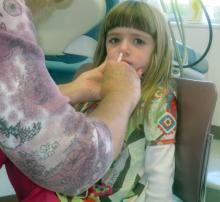The severity of the illness caused by the 2009 H1N1 pandemic was no worse than that caused by seasonal influenza A in a Wisconsin population of 50,000 children and adults, according to a report in the Sept. 8 JAMA.
"Our results suggest that the clinical manifestations and risk of hospital admission are similar for the 2009 H1N1 and other seasonal influenza A strains among those presenting for medical care and documented to have influenza infection," said Dr. Edward A. Belongia of the Marshfield (Wisc.) Clinic Research Foundation and his associates.
Previous studies have been unable to make direct comparisons of the spectrum of influenza illnesses because all the data on H1N1 have been surveillance data, particularly reports on hospital admissions and fatalities. "These reports have provided valuable descriptive information, but differing criteria for influenza testing by season and the lack of uniform standards for data collection and reporting limit comparisons with other influenza viruses," Dr. Belongia and his colleagues said.
By contrast, their study made comparisons using a defined population in which enrollment and laboratory methods were consistent across all subjects. The researchers compared the characteristics of the illness caused by the pandemic with those of the illness caused by seasonal flu infection using both inpatient and outpatient medical records for all residents of 14 ZIP code areas surrounding Marshfield, an area home to approximately 50,000 people who receive all their medical care at the clinic facilities.
All patients who presented for medical care with at least one flu symptom were tested for influenza using nasopharyngeal or nasal swabs. The study periods encompassed 10 weeks during the 2007-2008 flu season, 12 weeks during the 2008-2009 flu season, and 27 weeks during the 2009 pandemic.
There were 545 cases of 2009 H1N1 infection, 221 cases of seasonal H1N1 in 2008-2009, and 632 cases of H3N2 infection in 2007-2008.
Symptom severity scores were calculated for each patient based on self- or parental report of the severity of cough, fever, chills, fatigue, nasal congestion, wheezing, vomiting, headache, muscle ache, sore throat, ear pain, and nausea. Possible scores ranged from 1 for a single mild symptom to 36 for 12 severe symptoms.
Symptom severity scores were comparable for the three infections, with a median score of 14 for 2009 H1N1, 16 for the 2008-2009 seasonal flu, and 17 for 2007-2008 seasonal flu. The proportion of patients who received antiviral medications was similar in all three study groups.
The cumulative incidence of hospital admission within 30 days of onset per 1,000 residents was 0.25 for H1N1, 0.15 for seasonal flu in 2008-2009, and 0.50 for seasonal flu in 2007-2008, which are nonsignificant differences, Dr. Belongia and his associates wrote (JAMA 2010;304:1091-8).
"Other published studies have reported a higher than expected incidence of hospitalization and death associated with 2009 H1N1 infection, particularly in children. This finding may be due to the greatly elevated incidence of 2009 H1N1 influenza in a highly susceptible population of children and young adults rather than increased virulence of 2009 H1N1 relative to seasonal influenza A viruses," they said.
The investigators cautioned that their findings regarding the most serious outcomes, such as pneumonia, were limited by the fact that there was a very low number of such outcomes in all the study groups.
This study was funded by a grant from the Centers for Disease Control and Prevention. No financial conflicts of interest were reported.


